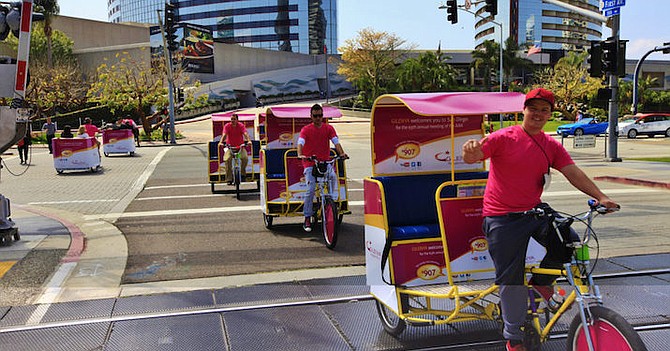 Facebook
Facebook
 X
X
 Instagram
Instagram
 TikTok
TikTok
 Youtube
Youtube

An eco-friendly way to tour San Diego. An advertising machine. A ride to the airport. Pedicabs have long had their niche in the city, but many of the businesses have been swept off the streets in recent years.
The downfall began in 2015, when the San Diego Police Department took over the permitting of pedicabs and would no longer permit electric-assisted ones because state vehicle code defined pedicabs as powered by people. Goodbye, electric cheats; hello, tired legs.
In 2018, the city stuck with the ban when the council decided, among other code changes that regulated noise, flashing lights on cabs, and fare gouging, that pedicabs must be human-powered.
Now, in keeping with a new state law that treats a three-wheeled pedicab as an electric bicycle, the ban is off. On Tuesday (March 15), the city will amend its pedicab ordinance, once more allowing electric-assisted three-wheelers. Will it revive the pared down industry, which now seems more focused on marketing messages than travel?
"We see some pedicabs with electric assist on them but our company is not using any at this time," says an email from Yellow Bike Pedicab in the Gaslamp. "We are considering but want to see how it's going first."
The city's ban on electric pedicabs included "specialized" four-wheelers that seat up to 15 people and operate through pre-booked tours, stopping at local restaurants, bars, or tourist spots on a scheduled route. The city had one such business operating with seven specialized pedicabs.

Under the amended ordinance, four-wheelers will continue to be barred from using a pedal assist device because the change in state law doesn't apply to specialized pedicabs, according to the city.
San Diego has regulated pedicabs since January 1, 2000 by requiring owners and operators to obtain a police permit. As the number of pedicabs grew over the years, so did complaints from downtown residents and businesses, including worries about electric devices mounted on cabs.
Pedicab drivers also felt the sting of rising costs needed to pay for enforcement - the $212 operator fee nearly doubled in July 2018.
By night, when the bars and restaurants are busy, pedicabs can be found hanging around the Gaslamp. In the day, the Harbor calls. For some drivers, the job will get easier now, as Yellow Bike Pedicab points out.
"Pure pedaling is very difficult."


An eco-friendly way to tour San Diego. An advertising machine. A ride to the airport. Pedicabs have long had their niche in the city, but many of the businesses have been swept off the streets in recent years.
The downfall began in 2015, when the San Diego Police Department took over the permitting of pedicabs and would no longer permit electric-assisted ones because state vehicle code defined pedicabs as powered by people. Goodbye, electric cheats; hello, tired legs.
In 2018, the city stuck with the ban when the council decided, among other code changes that regulated noise, flashing lights on cabs, and fare gouging, that pedicabs must be human-powered.
Now, in keeping with a new state law that treats a three-wheeled pedicab as an electric bicycle, the ban is off. On Tuesday (March 15), the city will amend its pedicab ordinance, once more allowing electric-assisted three-wheelers. Will it revive the pared down industry, which now seems more focused on marketing messages than travel?
"We see some pedicabs with electric assist on them but our company is not using any at this time," says an email from Yellow Bike Pedicab in the Gaslamp. "We are considering but want to see how it's going first."
The city's ban on electric pedicabs included "specialized" four-wheelers that seat up to 15 people and operate through pre-booked tours, stopping at local restaurants, bars, or tourist spots on a scheduled route. The city had one such business operating with seven specialized pedicabs.

Under the amended ordinance, four-wheelers will continue to be barred from using a pedal assist device because the change in state law doesn't apply to specialized pedicabs, according to the city.
San Diego has regulated pedicabs since January 1, 2000 by requiring owners and operators to obtain a police permit. As the number of pedicabs grew over the years, so did complaints from downtown residents and businesses, including worries about electric devices mounted on cabs.
Pedicab drivers also felt the sting of rising costs needed to pay for enforcement - the $212 operator fee nearly doubled in July 2018.
By night, when the bars and restaurants are busy, pedicabs can be found hanging around the Gaslamp. In the day, the Harbor calls. For some drivers, the job will get easier now, as Yellow Bike Pedicab points out.
"Pure pedaling is very difficult."
Comments